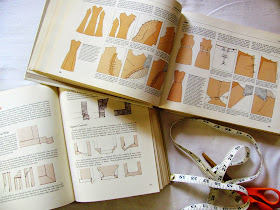Home
▼
Friday, August 8, 2014
4 Sewing Books to Add to Your Sewing Library
This set of four books was chosen for it's range, appeal to all skill levels, and quality of illustration and visuals. These are also new enough to be valid with current sewing machines and most modern textiles. Learning to refer to a quality resource such as these will make any sewing project go more smoothly and with more professional results.
"Why a sewing book? Can't I just use the pattern instructions?" Pattern companies don't include detailed instructions with sewing patterns. While they may suggest a process for construction or what to do first, second and third, they assume the person sewing knows how to sew each technique mentioned. Having a sewing manual will give you step-by-step help when using a sewing pattern.
"Can't I just go online and find the answer there?" Online resources vary from professional educators sharing online with their students, to first time users offering flawed and incomplete advice. Books have editors who make sure that the content is correct. This will save you from wading through the inaccurate technical advice online, and provide a consistent method of sewing.
If you learned to sew in the late 1960's, you no doubt may own one or both of these books. The Reader's Digest Complete Guide to Sewing (upper right) is probably the best book on techniques ever published, and while it continues to be edited and published today, it is the older editions, crammed with clearly detailed drawing that make it an all time favorite, first published in 1976. Those early editions include a good chapter on men's tailoring as well as all the basics, including pages on textiles. More recent versions leave out many techniques in favor of big colored photos and simple 'how to' projects. Both costumers and fashion students rely on this hefty book for it's endless coverage of nearly every technique imaginable.
Less comprehensive, The Vogue Sewing Book, (lower left)was designed for more advanced dress making projects, and was known for it's 'couture' techniques. The back end also covers men's tailoring, and the front sections are devoted to showing alterations, style tips and fabric glossary. The first edition was published in 1970.
These two sewing manuals are more recent publications. The Vogue/Butterick: Step-by-Step Guide to Sewing Techniques (left)was published in 1989, and carries on the tradition of step-by-step illustrations to guide the sewist through specific techniques. The drawing are large, clear and have simple descriptions. Unique to book organization, the processes are arranged alphabetically, rather than by method or topic. This publication has had several editions, sometimes with name changes, but it is worth seeking one out, even the oldest ones like this.
Singer: Sewing Step-by-Step (upper right) was an innovative publication in its day, due to the inclusion of many fine tuned photos, rather than drawings or diagrams, that illustrated the sewing techniques. Published in 1990, it was part of a huge project under the Singer name to produce a wide range of step-by-step books on a many sewing topics. You will often find other books from this series, and all are worth owning.
Content for this Step-by-Step tries to cover alot of territory, so it is not a deep study of sewing, more a good companion for the newer sewist. Topics such as: activewear, tailoring and heirloom sewing are included. For those new to sewing, the photos are a big help, and answer many questions that a drawing might not. A large portion of the book is dedicated to home decorating projects, a good move on their part because this was becoming the newest trend in home sewing. So if you are also seeking some tips for curtains, drapes, and bed coverings, this publication may be helpful.
While it's impossible to specify only four great sewing books, I will put these up as four of the best sewing books published since 1970. Why 1970? That was probably the 'Golden Era' of home sewing. Using domestic sewing machines that were available with zig-zag and could sew knits, it was possible to create nearly anything desired. These sewing books were introduced into classrooms, workshops and sat on nearly every living room bookcase, and all four have value today for current sewing projects.
Do I have other books that I like to use? Yes, of course. I find that the pre-1970 sewing texts have a charm and provide insight into techniques we don't use often today, but might if we knew more about them. I will share some of those in another post. As for new books, I have used some, especially those published by the major textbook companies that are worth owning as well, so I will share those later too.




